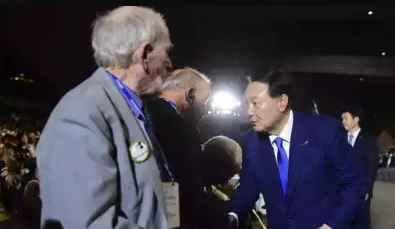In a bold display of defiance against the United States and a show of deepening ties with Moscow and Beijing, North Korean leader Kim Jong Un presented his most powerful nuclear-capable missiles during a military parade in Pyongyang. The parade, which coincided with a major war anniversary, featured senior delegates from Russia and China, symbolizing North Korea’s efforts to bolster its alliances amidst heightened tensions on the Korean Peninsula.
State media reported that the parade took place in Kim Il Sung Square, named after Kim’s grandfather, the founder of North Korea. The streets and stands were packed with tens of thousands of mobilized spectators, roaring in approval as troops, tanks, and intercontinental ballistic missiles (ICBMs) were showcased in the procession. The event drew attention to North Korea’s military capabilities, including the unveiling of newly developed surveillance and attack drones.
Notably, the parade featured two new ICBMs, the Hwasong-17 and Hwasong-18, both of which were flight-tested in recent months. These missiles demonstrated ranges that could potentially reach deep into the U.S. mainland, heightening concerns about North Korea’s nuclear program.
In a rare diplomatic opening amid the pandemic, Kim Jong Un was joined by Russian Defense Minister Sergei Shoigu and Chinese ruling party official Li Hongzhong. The presence of these high-level delegates highlighted the growing cooperation between North Korea and its authoritarian allies, seeking to counter the pressure exerted by the United States.
Kim’s recent meetings with Shoigu in Pyongyang underscored North Korea’s support for Russia’s invasion of Ukraine and raised suspicions about potential arms supply agreements between the two nations. A letter published by North Korean state media showed Russian President Vladimir Putin expressing gratitude for North Korea’s support during the Ukrainian conflict.
Amid the parade festivities, Kim hosted a luncheon and dinner banquet for Shoigu and his delegation to discuss expanding strategic and tactical collaboration in defense and security. This interaction further solidified the strengthening bond between North Korea, Russia, and China, drawing international attention and concern.
The military parade marked the 70th anniversary of the armistice that ended the 1950-53 Korean War. Despite the truce, a formal peace treaty was never established, leaving the Korean Peninsula technically in a state of war. The North sees the armistice as a victory in the “Grand Fatherland Liberation War.”
As tensions continue to rise, the international community remains vigilant about the implications of North Korea’s nuclear ambitions. U.N. Secretary-General Antonio Guterres expressed concern over the growing “nuclear risk” on the Korean Peninsula, calling for continued efforts to address the situation and maintain stability in the region.
South Korean President Yoon Suk Yeol also visited a war cemetery in Busan to commemorate foreign troops who fought for the South during the Korean War. In response to North Korean threats, President Yoon seeks to expand military exercises with the United States and secure stronger reassurances of U.S. support against a nuclear attack.
The parade’s demonstration of nuclear-capable missiles and the presence of Russian and Chinese delegates have raised serious questions about the global security implications of North Korea’s actions. As the situation continues to evolve, international leaders are closely monitoring the developments on the Korean Peninsula.

